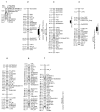Life-history QTLS and natural selection on flowering time in Boechera stricta, a perennial relative of Arabidopsis
- PMID: 21083662
- PMCID: PMC3155413
- DOI: 10.1111/j.1558-5646.2010.01175.x
Life-history QTLS and natural selection on flowering time in Boechera stricta, a perennial relative of Arabidopsis
Abstract
Plants must precisely time flowering to capitalize on favorable conditions. Although we know a great deal about the genetic basis of flowering phenology in model species under controlled conditions, the genetic architecture of this ecologically important trait is poorly understood in nonmodel organisms. Here, we evaluated the transition from vegetative growth to flowering in Boechera stricta, a perennial relative of Arabidopsis thaliana. We examined flowering time QTLs using 7920 recombinant inbred individuals, across seven laboratory and field environments differing in vernalization, temperature, and photoperiod. Genetic and environmental factors strongly influenced the transition to reproduction. We found directional selection for earlier flowering in the field. In the growth chamber experiment, longer winters accelerated flowering, whereas elevated ambient temperatures delayed flowering. Our analyses identified one large effect QTL (nFT), which influenced flowering time in the laboratory and the probability of flowering in the field. In Montana, homozygotes for the native allele at nFT showed a selective advantage of 6.6%. Nevertheless, we found relatively low correlations between flowering times in the field and the growth chambers. Additionally, we detected flowering-related QTLs in the field that were absent across the full range of laboratory conditions, thus emphasizing the need to conduct experiments in natural environments.
© 2010 The Author(s). Evolution© 2010 The Society for the Study of Evolution.
Figures





References
-
- Abe M, Kobayashi Y, Yamamoto S, Daimon Y, Yamaguchi A, Ikeda Y, Ichinoki H, Notaguchi M, Goto K, Araki T. FD, a bZIP protein mediating signals from the floral pathway integrator FT at the shoot apex. Science. 2005;309:1052–1056. - PubMed
Publication types
MeSH terms
Grants and funding
LinkOut - more resources
Full Text Sources
Other Literature Sources
